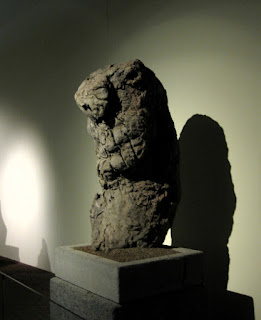Sunday morning on Jeju as I type to catch up on the past two days of adventures. Yesterday first because our visit to the Jeju Stone Park was the most memorable of our recent activities. With all the rocks that I "harvest" from the fields at the ranch, you wouldn't think a museum dedicated to rocks would be high on my list of places see on the other side of the world. It actually
was on my list because it is both an indoor and outdoor museum, mixing mythical tales with science, and an ecological park that also showcases the life of the early people of Jeju.
Dozens of these statues, with slightly different shapes and head rocks, lined the trail to the entrance. They represent the five hundred soldiers whose mother sacrificed her life so they could live. The indoor museum of the facility contained displays and artifacts telling of the geology of Jeju, created about 2-3 million years ago by volcanic activity. Jeju Island did not exist until the underwater volcanos began erupting and depositing lava, enough to form the island. The last volcano erupted over 1000 years ago and no more activity is seen by the geologists.
As the lava cooled and hardened, natural forces and the composition of the lava created more than just big black rocks. My favorite part of the day was admiring the lava that was displayed as artwork. Even Phillip enjoyed it, as we could imagine shapes or animals in the displayed lava rock.
The museum did an excellent job with the lighting on some of the displays, using it to enhance the otherworldly nature of the pieces.
That was just a taste of the amazing pieces, all naturally occurring lava rock, not formed or shaped by humans. We see the patterns and admire to beauty, but nature made them. There were a lot of statues, outside on the hundreds of acres of the Store Park, that were formed by human hands from the lava rock. I see Ed Asner in this one:
Two walking courses after the museum led us thru wooded and cleared areas where the evolving cultural uses of the lava rocks were displayed.
It is spring here, so the brushy foliage is still a light green, reminiscent of the color of mesquite leaves, but it isn't mesquite, rather some type of thornless bramble that lined a lot of the paths that weren't thru the forested areas.

This is from our next stop, the Sangumburi Crater. The viewing area was too close for my camera to get a complete shot of the crater. This crater is significant because is one of only a few in the world that was created from an explosion without the ejection of lava or ash. It is a perfect bowl, unlike the other craters which have a chunk out of one side where the lava spilled out. Although, of course, there were stairs leading up the viewing area, this is also considered a "flatland crater," as the sides are relatively short, but the pit inside is deeper than the surrounding terrain. No water or crater lake since the volcanic rock is porous; however, the vegetation growing inside the crater is of scientific interest.
Here's my final "rock as art" picture before I describe Friday's travels. While walking to the crater from the main road, we passed a stone wall with rock critters adorning it. Standing alligators, lions, and this interesting rabbit, or rather rabbit head on a person.

I like this picture from Friday, although we saw many, many versions of this guy at the store park... and everywhere around the island. It is "grandfather rock," dolharubang. The originals were first carved in 1750 and placed around the island's fortresses to ward off evil. Over the centuries, dolharubang were placed everywhere, at entrances, on the ends of bridges, in parks, and today, at every souvenir stand! These guys were at the entrance to Jungmun Resort. Phillip and I traveled to the south end of the island to eat at a restaurant in the resort. It was our only disappointment of the trip, over-priced and not everything that was advertised. Oh well, my raw tuna slices there were excellent. After that experience, we walked to a few waterfalls, including this one, Jeongbang, which is the only waterfall in Asia that drops directly into the sea.

The Stone Park was not crowded, but every other place we have visited does have throngs of people. Here is a glimpse of about a hundred of our friends who were also visiting Jeongbang on Friday:
Red shirt, GoPro on a stick on the right side of the picture. That's Phillip. He's not out of place with his Go-Pro stick as about 20% of the folks have a self-stick for their cell phones, and 95% of the people have cell phones that they use as cameras. I'm part of the 5% that use REAL cameras!













No comments:
Post a Comment